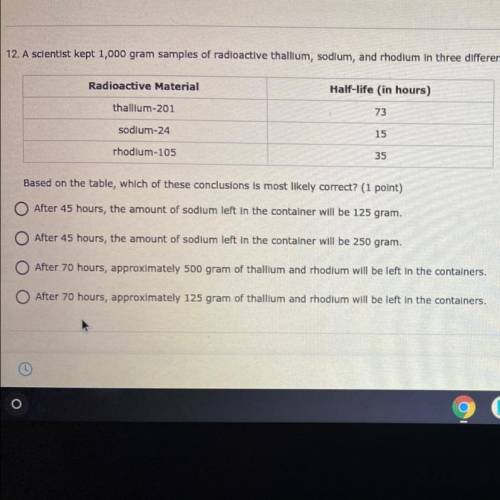
A scientist kept 1,000 gram samples of radioactive thallium, sodium, and rhodium in three different containers. The table below shows the half-lives of the
Radioactive Material
Half-life (in hours)
73
thallium-201
sodium-24
rhodium-105
15
35
Based on the table, which of these conclusions is most likely correct? (1 point)
After 45 hours, the amount of sodium left in the container will be 125 gram.
After 45 hours, the amount of sodium left in the container will be 250 gram.
After 70 hours, approximately 500 gram of thallium and rhodium will be left in the containers.
After 70 hours, approximately 125 gram of thallium and rhodium will be left in the containers.


Answers: 2


Another question on Biology

Biology, 22.06.2019 11:00
Membrane vesicles containing an internal sodium chloride (nacl) concentration of 0.14 m are placed into separate beakers each containing a different solution. the first beaker contains 0.14 m sucrose, while the second beaker contains 0.14 m calcium chloride (cacl2). the temperature is 25°c. what is the solute potential inside the vesicles, expressed in units of mpa?
Answers: 2

Biology, 22.06.2019 15:40
During crossing-over, a. genetic material is exchanged between nonsister chromatids, resulting in new combinations of alleles. b. nonsister chromatids from each homologous chromosome of a tetrad are exchanged, resulting in new combinations of alleles. c. one homologous chromosome of a tetrad is exchanged with another tetrad, resulting in new combinations of alleles. d. sister chromatids from each homologous chromosome of a tetrad are exchanged, resulting in new combinations of alleles. e. genetic material is exchanged between sister chromatids, resulting in new combinations of alleles.
Answers: 1

Biology, 22.06.2019 16:30
Monarch butterflies have brightly colored orange wings with black patterns on them, making them easily visible to birds that eat butterflies and moths, yet birds rarely eat the monarchs. likewise, the monarch caterpillars are brightly striped yellow and white and black, and they also are rarely eaten by birds, although some wasps will attack them and feed them to their young. what can be inferred from these observations? monarchs must threaten and attack birds, but not wasps. monarchs have a way of discouraging bird predation that does not involve hiding. monarchs’ wings are so colorful that most birds must find them difficult to eat. monarchs lay more eggs than other less conspicuous butterflies.
Answers: 2

Biology, 22.06.2019 23:00
If you continued to heat a pot of water after in reached its boiling point, what would happen
Answers: 2
You know the right answer?
A scientist kept 1,000 gram samples of radioactive thallium, sodium, and rhodium in three different...
Questions

Mathematics, 05.03.2021 03:40

Mathematics, 05.03.2021 03:40

History, 05.03.2021 03:40





Mathematics, 05.03.2021 03:40

Mathematics, 05.03.2021 03:40


Physics, 05.03.2021 03:40

Mathematics, 05.03.2021 03:40










